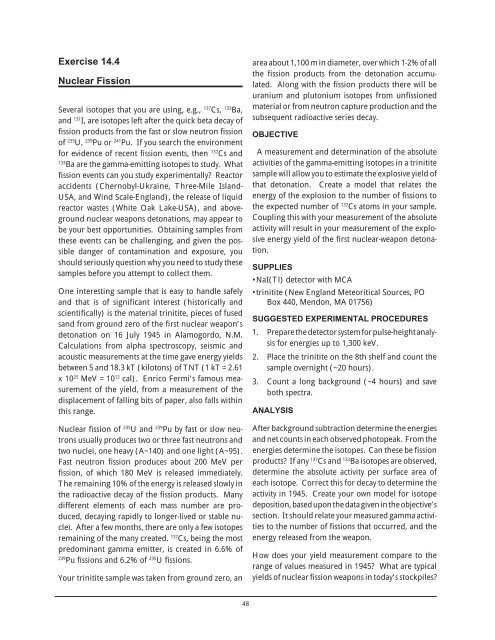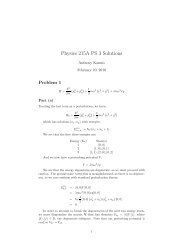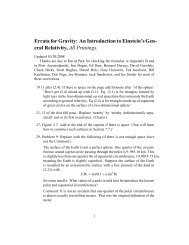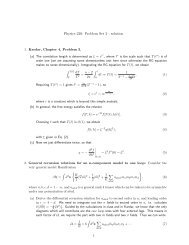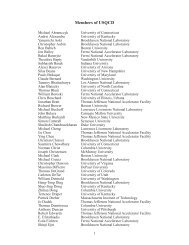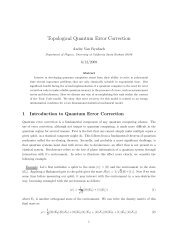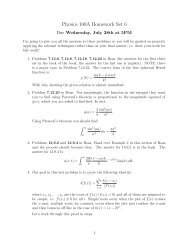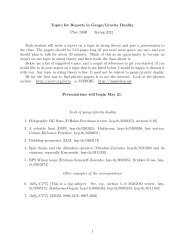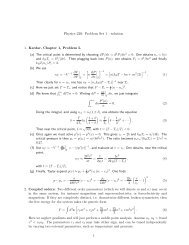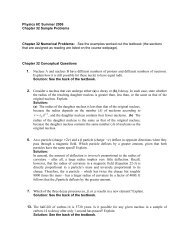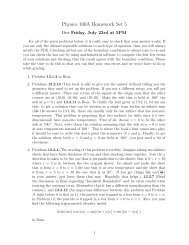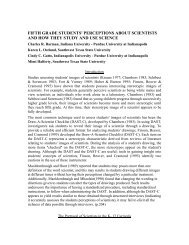Nuclear Spectroscopy
Nuclear Spectroscopy
Nuclear Spectroscopy
Create successful ePaper yourself
Turn your PDF publications into a flip-book with our unique Google optimized e-Paper software.
Exercise 14.4<br />
<strong>Nuclear</strong> Fission<br />
Several isotopes that you are using, e.g., 137 Cs, 133 Ba,<br />
and 131 I, are isotopes left after the quick beta decay of<br />
fission products from the fast or slow neutron fission<br />
of 235 U, 239 Pu or 241 Pu. If you search the environment<br />
for evidence of recent fission events, then 137 Cs and<br />
133<br />
Ba are the gamma-emitting isotopes to study. What<br />
fission events can you study experimentally? Reactor<br />
accidents (Chernobyl-Ukraine, Three-Mile Island-<br />
USA, and Wind Scale-England), the release of liquid<br />
reactor wastes (White Oak Lake-USA), and aboveground<br />
nuclear weapons detonations, may appear to<br />
be your best opportunities. Obtaining samples from<br />
these events can be challenging, and given the possible<br />
danger of contamination and exposure, you<br />
should seriously question why you need to study these<br />
samples before you attempt to collect them.<br />
One interesting sample that is easy to handle safely<br />
and that is of significant interest (historically and<br />
scientifically) is the material trinitite, pieces of fused<br />
sand from ground zero of the first nuclear weapon’s<br />
detonation on 16 July 1945 in Alamogordo, N.M.<br />
Calculations from alpha spectroscopy, seismic and<br />
acoustic measurements at the time gave energy yields<br />
between 5 and 18.3 kT (kilotons) of TNT (1 kT = 2.61<br />
x 10 25 MeV = 10 12 cal). Enrico Fermi’s famous measurement<br />
of the yield, from a measurement of the<br />
displacement of falling bits of paper, also falls within<br />
this range.<br />
<strong>Nuclear</strong> fission of 235 U and 239 Pu by fast or slow neutrons<br />
usually produces two or three fast neutrons and<br />
two nuclei, one heavy (A~140) and one light (A~95).<br />
Fast neutron fission produces about 200 MeV per<br />
fission, of which 180 MeV is released immediately.<br />
The remaining 10% of the energy is released slowly in<br />
the radioactive decay of the fission products. Many<br />
different elements of each mass number are produced,<br />
decaying rapidly to longer-lived or stable nuclei.<br />
After a few months, there are only a few isotopes<br />
remaining of the many created. 137 Cs, being the most<br />
predominant gamma emitter, is created in 6.6% of<br />
239<br />
Pu fissions and 6.2% of 235 U fissions.<br />
Your trinitite sample was taken from ground zero, an<br />
area about 1,100 m in diameter, over which 1-2% of all<br />
the fission products from the detonation accumulated.<br />
Along with the fission products there will be<br />
uranium and plutonium isotopes from unfissioned<br />
material or from neutron capture production and the<br />
subsequent radioactive series decay.<br />
OBJECTIVE<br />
A measurement and determination of the absolute<br />
activities of the gamma-emitting isotopes in a trinitite<br />
sample will allow you to estimate the explosive yield of<br />
that detonation. Create a model that relates the<br />
energy of the explosion to the number of fissions to<br />
the expected number of 137 Cs atoms in your sample.<br />
Coupling this with your measurement of the absolute<br />
activity will result in your measurement of the explosive<br />
energy yield of the first nuclear-weapon detonation.<br />
SUPPLIES<br />
•NaI(Tl) detector with MCA<br />
•trinitite (New England Meteoritical Sources, PO<br />
Box 440, Mendon, MA 01756)<br />
SUGGESTED EXPERIMENTAL PROCEDURES<br />
1. Prepare the detector system for pulse-height analysis<br />
for energies up to 1,300 keV.<br />
2. Place the trinitite on the 8th shelf and count the<br />
sample overnight (~20 hours).<br />
3. Count a long background (~4 hours) and save<br />
both spectra.<br />
ANALYSIS<br />
After background subtraction determine the energies<br />
and net counts in each observed photopeak. From the<br />
energies determine the isotopes. Can these be fission<br />
products? If any 137 Cs and 133 Ba isotopes are observed,<br />
determine the absolute activity per surface area of<br />
each isotope. Correct this for decay to determine the<br />
activity in 1945. Create your own model for isotope<br />
deposition, based upon the data given in the objective’s<br />
section. It should relate your measured gamma activities<br />
to the number of fissions that occurred, and the<br />
energy released from the weapon.<br />
How does your yield measurement compare to the<br />
range of values measured in 1945? What are typical<br />
yields of nuclear fission weapons in today’s stockpiles?<br />
48


